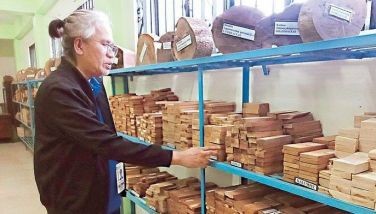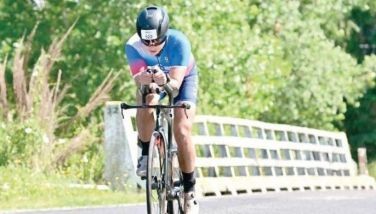These kids walk 6 kilometers to school
November 25, 2006 | 12:00am
TOMAS OPPUS, Southern Leyte - High school students get up around 5:00 a.m. or earlier just to prepare for school.
Then they have to walk about an hour, a long six kilometers, just to reach a school before the start of classes at 7:20 a.m.
This is not "Ang Daan Patungong Kalimugtong," the documentary film by Mes de Guzman about highland school children who have to traverse streams and mountain passes just to get to school. The same youthful perseverance for an education is seen in this small town of Tomas Oppus, Leyte.
After school, at around 5:00 p.m., the kids have to walk again an hour or more, six kilometers back to their homes, to study and prepare for the next day’s school work.
For a high school student of the Rizal National High School located in this town, a remote area in a hilly location of Southern Leyte, the daily exercise is just par for the course.
Sometimes, when the weather is bad, the students walk through rain and mud before they even start the day at school, school officials told reporters during a tour of the province arranged by the Asian Development Bank and the Department of Education (DepEd).
But in spite of all the hardships, including financial difficulties, the children mostly coming from poor families are serious in finishing their studies, and one day hope to help their parents and siblings live a better life.
And against all odds, one of the classes, a group of now second year high school, topped this year’s National Achievement Test (NAT) given last March in the Filipino, Mathematics and English categories.
In an interview with the school principal the other day, Margarita Badeo said the school only has one class in each of the four high school levels, resulting in more focused teaching.
Class size is only about 40 to 50 students. The NAT top achievers class is composed of only 42 students.
Badeo said the school only has 194 students, six classrooms, one for each level and two extra classrooms for other subjects.
They have complete facilities, including a library, a laboratory, two personal computers donated by a congressman, and other equipment.
With the help of a project called the Secondary Education Development and Improvement Project (SEDIP), a program of DepEd and the Asian Development Bank (ADB), the school has improved by leaps and bounds, said Badeo.
Education officials are now looking at the possibility of using Southern Leyte as a role model in studying techniques for other far-flung areas in the country and even in Metro Manila.
Dr. Lolita Andrada, head of the Bureau of Secondary Education at the DepEd, told reporters that the students’ study methods have become a model and they would like to see how it can be adapted to schools in other provinces and later in Metro Manila.
According to Andrada, based on their assessments, students were able to concentrate more on their studies when they were presented with a provincial-driven type of mindset.
Andrada said that with such "provincial mindset," the teachers are encouraged to devise innovative lesson plans supported by parents, co-workers and especially the students who participate in class.
Andrada said that the students are being asked to concentrate only on their studies and leave work to their parents.
Southern Leyte is one of the provinces where the SEDIP is being implemented, with a $53 million ADB loan in 1998.
The project benefits over a million high school students in 26 very poor provinces where enrollment, completion, and student performance levels were low. It aims to improve the quality of secondary education and access to such education in those provinces.
Under SEDIP, school heads are trained in planning and management while teachers are trained in subject knowledge and teaching skills. The project has provided textbooks for all students in core subjects including Math, Science, English, and Filipino. Some of those unable to attend school regularly have an alternative secondary education program.
Innovative ways to keep the students in school have also been developed, and some schools even have their own feeding program. It has also promoted the decentralization of secondary education management by building up the capacity of divisions, regions, and central offices to take on new responsibilities.
Andrada said that unlike in Metro Manila, students’ attention is usually divided, since instead of studying, they indulge in television, games, computers and the Internet.
Far-flung provinces, on the other hand, have barely enough resources compared with those closer to the capital. Yet students there do well or even better than those studying in Metro Manila.
At the Rizal National High School in Tomas Oppus, Clarissa Torrion, the school’s valedictorian and a member of the class that topped the NAT last March, said that she always wanted to be a teacher herself.
Torrion said that since they have no other things to do and she recognizes the importance of finishing school, she concentrates on school work.
Dr. Violeta Alocilja, Division Superintendent of Southern Leyte, said the NAT results were significant as they were once ranked second to the last in the region.
Five other public high schools in the province landed in the top 30 while 11 elementary schools are also among the top 30.
The top three schools and their mean percentage scores (MPS) are Rizal National High School in Tomas Oppus with 81.48, Marayag National High School in San Francisco with 79.07 and Pintuyan National Vocational High School in Pintuyan with 78.69.
These schools are located in 5th class municipalities.
The three top schools and five others, which are all located in backwater municipalities of the province, were among the 5,700 public schools nationwide that took the NAT for first year students.
The five other high schools in the province with their ranking are Limasawa National High School, Limasawa, 77.41 MPS at 7th; Sta. Paz Norte National High School, in San Francisco, 77.25 MPS at 8th; Concepcion National High School, Malitbog, 76.60 MPS at 15th; Divisoria National High School, Bontoc, 76.23 MPS at 17th and San Isidro National High School, Tomas Oppus, 75.55 MPS at 29th.
The Bureau for Secondary Education (BSE) under the DepEd is implementing the project. ADB’s contribution in the "soft" areas — such as in capacity development, school development, alternative school programs and teaching-learning materials – is complemented by the Japan Bank for International Cooperation, which supports the project through school equipment and infrastructure development like constructing new schools and new classrooms for existing schools.
"SEDIP played a very significant role in influencing learning. It is also the stimulus which developed the schools with all the inputs, learning packages and in-service training. It revitalized learning in the classroom. The learning that the school heads gathered from the training significantly developed their competence to lead the schools," Alocilja said.
Then they have to walk about an hour, a long six kilometers, just to reach a school before the start of classes at 7:20 a.m.
This is not "Ang Daan Patungong Kalimugtong," the documentary film by Mes de Guzman about highland school children who have to traverse streams and mountain passes just to get to school. The same youthful perseverance for an education is seen in this small town of Tomas Oppus, Leyte.
After school, at around 5:00 p.m., the kids have to walk again an hour or more, six kilometers back to their homes, to study and prepare for the next day’s school work.
For a high school student of the Rizal National High School located in this town, a remote area in a hilly location of Southern Leyte, the daily exercise is just par for the course.
Sometimes, when the weather is bad, the students walk through rain and mud before they even start the day at school, school officials told reporters during a tour of the province arranged by the Asian Development Bank and the Department of Education (DepEd).
But in spite of all the hardships, including financial difficulties, the children mostly coming from poor families are serious in finishing their studies, and one day hope to help their parents and siblings live a better life.
And against all odds, one of the classes, a group of now second year high school, topped this year’s National Achievement Test (NAT) given last March in the Filipino, Mathematics and English categories.
In an interview with the school principal the other day, Margarita Badeo said the school only has one class in each of the four high school levels, resulting in more focused teaching.
Class size is only about 40 to 50 students. The NAT top achievers class is composed of only 42 students.
Badeo said the school only has 194 students, six classrooms, one for each level and two extra classrooms for other subjects.
They have complete facilities, including a library, a laboratory, two personal computers donated by a congressman, and other equipment.
With the help of a project called the Secondary Education Development and Improvement Project (SEDIP), a program of DepEd and the Asian Development Bank (ADB), the school has improved by leaps and bounds, said Badeo.
Education officials are now looking at the possibility of using Southern Leyte as a role model in studying techniques for other far-flung areas in the country and even in Metro Manila.
Dr. Lolita Andrada, head of the Bureau of Secondary Education at the DepEd, told reporters that the students’ study methods have become a model and they would like to see how it can be adapted to schools in other provinces and later in Metro Manila.
According to Andrada, based on their assessments, students were able to concentrate more on their studies when they were presented with a provincial-driven type of mindset.
Andrada said that with such "provincial mindset," the teachers are encouraged to devise innovative lesson plans supported by parents, co-workers and especially the students who participate in class.
Andrada said that the students are being asked to concentrate only on their studies and leave work to their parents.
Southern Leyte is one of the provinces where the SEDIP is being implemented, with a $53 million ADB loan in 1998.
The project benefits over a million high school students in 26 very poor provinces where enrollment, completion, and student performance levels were low. It aims to improve the quality of secondary education and access to such education in those provinces.
Under SEDIP, school heads are trained in planning and management while teachers are trained in subject knowledge and teaching skills. The project has provided textbooks for all students in core subjects including Math, Science, English, and Filipino. Some of those unable to attend school regularly have an alternative secondary education program.
Innovative ways to keep the students in school have also been developed, and some schools even have their own feeding program. It has also promoted the decentralization of secondary education management by building up the capacity of divisions, regions, and central offices to take on new responsibilities.
Andrada said that unlike in Metro Manila, students’ attention is usually divided, since instead of studying, they indulge in television, games, computers and the Internet.
Far-flung provinces, on the other hand, have barely enough resources compared with those closer to the capital. Yet students there do well or even better than those studying in Metro Manila.
At the Rizal National High School in Tomas Oppus, Clarissa Torrion, the school’s valedictorian and a member of the class that topped the NAT last March, said that she always wanted to be a teacher herself.
Torrion said that since they have no other things to do and she recognizes the importance of finishing school, she concentrates on school work.
Dr. Violeta Alocilja, Division Superintendent of Southern Leyte, said the NAT results were significant as they were once ranked second to the last in the region.
Five other public high schools in the province landed in the top 30 while 11 elementary schools are also among the top 30.
The top three schools and their mean percentage scores (MPS) are Rizal National High School in Tomas Oppus with 81.48, Marayag National High School in San Francisco with 79.07 and Pintuyan National Vocational High School in Pintuyan with 78.69.
These schools are located in 5th class municipalities.
The three top schools and five others, which are all located in backwater municipalities of the province, were among the 5,700 public schools nationwide that took the NAT for first year students.
The five other high schools in the province with their ranking are Limasawa National High School, Limasawa, 77.41 MPS at 7th; Sta. Paz Norte National High School, in San Francisco, 77.25 MPS at 8th; Concepcion National High School, Malitbog, 76.60 MPS at 15th; Divisoria National High School, Bontoc, 76.23 MPS at 17th and San Isidro National High School, Tomas Oppus, 75.55 MPS at 29th.
The Bureau for Secondary Education (BSE) under the DepEd is implementing the project. ADB’s contribution in the "soft" areas — such as in capacity development, school development, alternative school programs and teaching-learning materials – is complemented by the Japan Bank for International Cooperation, which supports the project through school equipment and infrastructure development like constructing new schools and new classrooms for existing schools.
"SEDIP played a very significant role in influencing learning. It is also the stimulus which developed the schools with all the inputs, learning packages and in-service training. It revitalized learning in the classroom. The learning that the school heads gathered from the training significantly developed their competence to lead the schools," Alocilja said.
BrandSpace Articles
<
>
- Latest
- Trending
Trending
Latest
Trending
Latest
Recommended






























